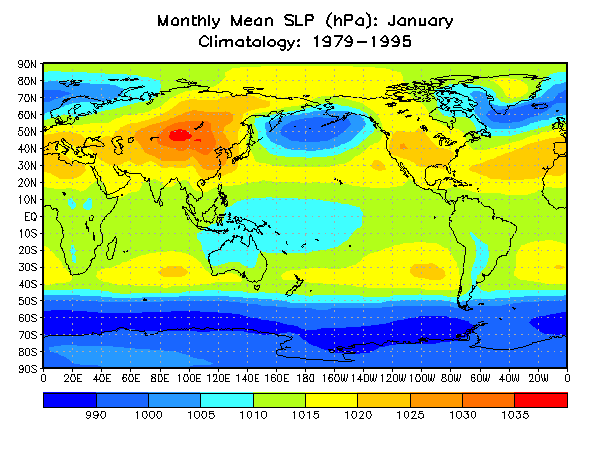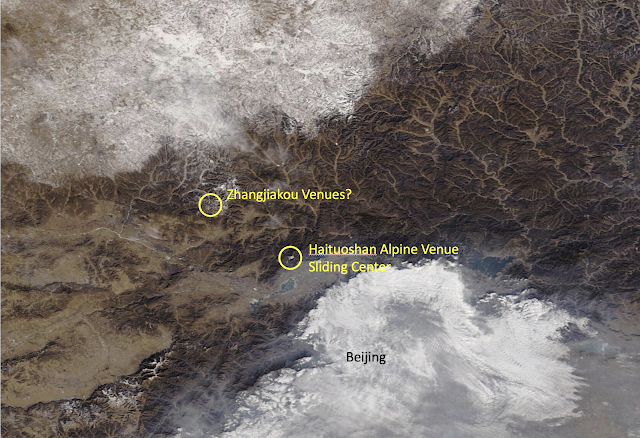The 2022 Olympic Winter Games start on February 4th. The host city is....Beijing, China? Weird. Beijing is not widely known for much related to snow and winter sports. Does it even get cold there? Let's take a look.
Beijing is in east Asia, just inland from the Yellow Sea. It is about 680 miles from Pyeongchang, South Korea, identified with the thumbnail below and host city for the 2018 Olympic Winter Games.
As is the case for much of east Asia, the winter climate of the region during winter is dominated by semi-permanent high pressure centered over interior Asia.
 |
| Source: NOAA/NWS Climate Prediction Center |
This means the wintertime climate of Beijing is quite dry. In February, the average precipitation (water equivalent) in Beijing is only 0.19" (1971-2000 normals from https://en.wikipedia.org/wiki/Geography_of_Beijing) compared to 1.30" in Salt Lake City (1991-2020 normals from https://www.weather.gov/wrh/climate?wfo=slc). I do not have snowfall numbers for Beijing, but if you convert 0.19" of water to snow assuming a generous snow-to-liquid ratio of 15:1 you get a whopping 3 inches. Beijing is also considerably drier than Pyeongchang, which averages 1.94" of precipitation in February (1991-2020 normals from https://en.wikipedia.org/wiki/Pyeongchang_County).
You may recall that Pyeongchang cold and windy, at least for many of the outdoor venues. Beijing is lower than Pyeongchang and thus the average maximum and minimum temperatures for February (41˚F and 22˚F; 1971-2000 normals) are higher than Pyeongchang (33˚F and 14˚F). I struggled to find more recent climate normals for Beijing and perhaps in the current climate they would be a couple of degrees higher. For further comparison, the 1991-2020 climate normals for Salt Lake City are 45˚F and 29˚F, so Beijing comes in a bit cooler.
That's all fine and dandy, but the Alpine skiing, Nordic skiing, Snowboarding, Biathalon, and Sliding competitions will held in either the Yanqing or Zhangjiakou Clusters in the mountains north of Beijing.
 |
| Source: https://olympic.weather.com.cn/ |
These are at higher elevations. Beijing is about 40-60 meters above sea level. In the Yanqing Cluster, the sliding center is at about 1000 meters and summit of the Haituoshan Mountain is just above 2000 meters. The Nordic center is at 1700 meters and roughly the same elevation as Soldier Hollow.
I haven't been able to locate short-term climate data specifically for these venues, but the 1971-2000 climate normals for Zhangjiakou at an elevation of 716 meters include and average high of 35˚F, average low of 14˚F, and average precipitation of 0.16". The story here once again is exceptional dryness, even in the mountains. Natural snowfall is scant. Baring a freak storm, there will be heavy reliance on artificial snow at every outdoor venue. Odds favor a few flurries or snow showers here or there and not much else.
The biggest weather-related concerns for the competitions are low temperatures, strong winds, blowing dust, and air pollution. The latter is strongly related to emissions and I suspect the Chinese will be taking actions to limit those, although I'm not sure they can fully reign in the problem in the Beijing area. Winds can be strong not only on ridgetops, but even at lower elevations during cold-air surges. Severe dust storms have occurred in Beijing in February.
Below is a modis satellite image from February 26th of last year. The Yellow Sea is evident on the left. Beijing would be just above the center of the photo. Note the thick pollution in Beijing and the adjoining lowlands and the lack of snow in the mountains to the north where many Olympic events will be held. The whitespot northeast of Beijing appears to be a frozen lake.
If we look at the last clear modis overpass on January 19th, there appears to be no natural snow at the Haituoshan Alpine Venue and sliding center. There may be a skiff of natural snow at the Zhangjiakou Venues, although I wasn't sure I had the location nailed down.
Artificial snow is increasingly important for winter sports competitions and for some, such as Alpine skiing, natural snow is more trouble than it is worth once the course is prepped. Additionally, Olympics have been held in cities that don't get a lot of snow (e.g., Vancouver, although snowfall is more plentiful in the adjoining mountains). Nevertheless, from a weather perspective, this looks to be an Olympics like none before.




Loving these posts! You might embed your links to improve readability. Keep up the good work!
ReplyDelete